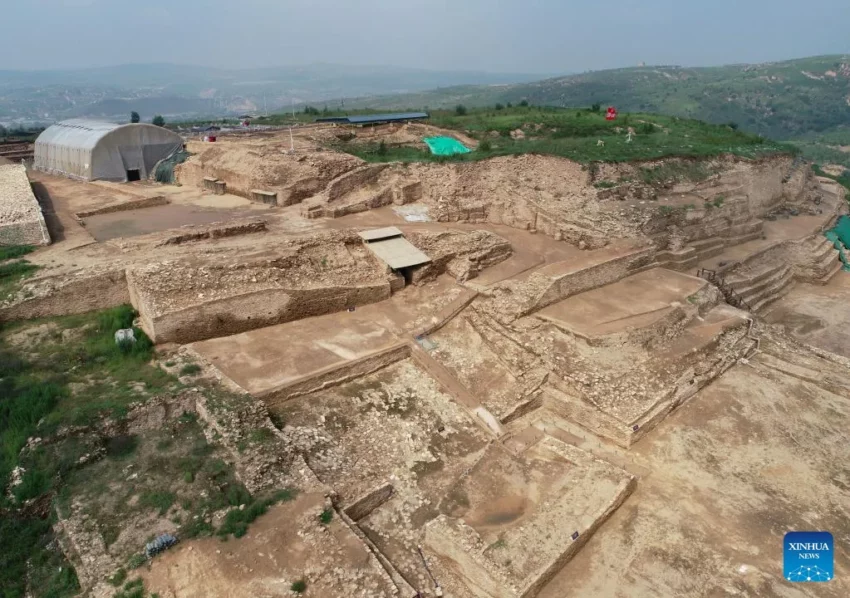Shimao, an ancient city in China, is a significant archaeological discovery that has reshaped our understanding of Chinese prehistory. The site, which spans over 4 square kilometers, includes a central pyramid, residential areas, and a complex system of fortifications. Its discovery has provided invaluable insights into the political, social, and cultural developments of early Chinese civilization.
Historical Background of Shimao
Archaeologists stumbled upon Shimao in the 1970s, but it wasn’t until 2011 that its true significance came to light. The site, located in Shaanxi Province, was initially thought to be part of the Great Wall. However, further excavations revealed a sophisticated city dating back to the late Neolithic period. The builders of Shimao remain a mystery, but evidence suggests it was a primary center of the late Longshan culture around 2300-1800 BCE.
Shimao’s inhabitants built massive city walls, inner and outer fortifications, and a central pyramid-like structure. The city’s design indicates a highly stratified society with complex urban planning. Over time, Shimao appears to have been abandoned, and its history was buried until recent archaeological efforts brought it back to light. It was not the scene of any known historical events, but its discovery has significantly impacted our understanding of early Chinese urbanization.
The city’s construction showcases the ingenuity of its builders. They used local materials, including stone, to create a durable and imposing structure. The central pyramid, rising above the city, suggests a religious or ceremonial purpose, possibly serving as a temple or palace. The presence of jade artifacts indicates the city’s importance and wealth.
Shimao’s decline and eventual abandonment remain enigmatic. There is no clear evidence of conquest or natural disaster. Instead, it may have been a gradual process influenced by changing social or environmental conditions. The site lay forgotten for millennia, overshadowed by the rise of other prominent Chinese civilizations.
Today, Shimao is a treasure trove for historians and archaeologists. Its discovery has prompted a reevaluation of the origins of Chinese civilization. The site provides a rare glimpse into a period of history that predates the Shang dynasty, traditionally considered the first historical Chinese dynasty. Shimao’s existence suggests that complex societies emerged in China much earlier than previously thought.
About Shimao
Shimao is a testament to the architectural prowess of its inhabitants. The central pyramid, standing at the heart of the city, is a marvel of ancient engineering. It spans 70 meters at its base and rises to a height of 18 meters. The pyramid’s layers were built using hand-laid stones, a technique that required significant labor and organization.
The city’s fortifications are equally impressive. The walls, stretching over 6 kilometers in length, were constructed with a careful selection of stone materials. These fortifications include various gates and watchtowers, indicating a high level of military sophistication. The walls not only served as defense mechanisms but also as a symbol of power and control.
Residential areas in Shimao were carefully planned. Houses were built with stone foundations and wooden superstructures. Archaeologists have found evidence of workshops, suggesting that the city was a hub for craft production, particularly for jade objects. The presence of such artifacts points to a complex economy and trade networks.
Shimao’s layout reflects a hierarchical society. The central pyramid and surrounding elite residences indicate a clear social stratification. Commoners likely lived in the outer areas of the city, with their status reflected in the quality and size of their dwellings.
The city’s design also reveals an advanced understanding of urban planning. Streets and buildings were laid out with intention, creating a functional and organized cityscape. This level of urban development challenges previous assumptions about the timeline of Chinese urbanization.
Theories and Interpretations
Several theories have emerged regarding Shimao’s purpose and the people who built it. Some scholars suggest it was a political center, a capital of a powerful chiefdom that exerted control over the region. Others believe it may have been a religious site, with the central pyramid serving as a temple.
The mystery of Shimao’s abandonment has led to various interpretations. Some argue that environmental changes, such as drought, could have made the area less hospitable. Others speculate that internal social strife or shifts in trade routes and political power could have contributed to its decline.
Matching Shimao to historical records is challenging due to its age. The site predates written Chinese history, so archaeologists rely on material evidence to piece together its story. The discovery of jade artifacts, some of which bear inscriptions, has provided some clues, but their exact significance is still debated.
Dating Shimao has been a complex task. Radiocarbon dating and stratigraphy have been used to establish a timeline for the city’s construction and occupation. These methods have confirmed that Shimao was a bustling center during the late Neolithic period.
The interpretations of Shimao are continually evolving as new discoveries are made. Each artifact and structure provides a piece of the puzzle, contributing to a broader understanding of this enigmatic site. As research continues, Shimao’s place in history becomes clearer, offering a window into a previously unknown chapter of Chinese civilization.
At a glance
Country: China
Civilization: Late Longshan culture
Age: Approximately 4,300 years old (2300-1800 BCE)
Conclusion and Sources
Reputable sources used in creating this article include:
Neural Pathways is a collective of seasoned experts and researchers with a profound passion for unraveling the enigmas of ancient history and artifacts. With a wealth of combined experience spanning decades, Neural Pathways has established itself as a leading voice in the realm of archaeological exploration and interpretation.

